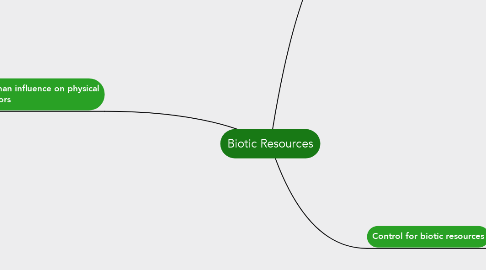
1. Human influence on physical factors
1.1. Climate
1.1.1. temperature - greenhouses/ polytunnels provide shelter when temperatures are low
1.1.2. precipitation - irrigation and drainage
1.1.3. insolation - artificial lighting/ selectively breed species requiring lower levels of insolation
1.2. Soils
1.2.1. Moisture content - ploughing improves aeration and soil water content
1.2.2. nutrients - artificial fertilisers/ crop rotation/ legume
1.2.3. organic content - added to improve soil structure/ aeration and water content
1.3. relief - steep sloped cultivated by creating terraces
1.4. infrastructure
1.4.1. transport
1.4.1.1. rural - little access to large transport vehicles/ links to market
1.4.1.2. urban - large transport vehicles to transport goods
1.4.2. commercial
1.4.2.1. rural - little access to shops and trade
1.4.2.2. urban - links with other countries to trade goods across sea
1.5. pricing and subsidies
1.5.1. :)
1.5.1.1. keeps prices of biotic resources low - available to wider market
1.5.1.2. keep farmers incomes up
1.5.1.3. keeps global supplies of products buoyant
1.5.2. :(
1.5.2.1. encourage farmers to overproduce certain products
1.6. trade organisations
1.6.1. WTO - increase international trade by lowering trade barriers
1.6.1.1. trade barriers - ensure imports are not cheaper than products made within country itself
1.6.1.2. protect domestic production
1.6.1.3. unsuccessful as this makes products more expensive for consumers so less are brought reducing LEDC income to spend on biotic resources they need
2. Gained from the biosphere
2.1. Food
2.1.1. plants
2.1.1.1. fruits
2.1.1.2. cereals
2.1.1.3. vegetables
2.1.2. Animals
2.1.2.1. mammals
2.1.2.2. birds
2.1.2.3. fish
2.2. Fibres
2.3. Timber
2.4. Bio-fuels
3. Control for biotic resources
3.1. Environmental
3.1.1. climate
3.1.1.1. precipitation
3.1.1.2. temperature
3.1.1.2.1. affects soil water availability
3.1.1.2.2. affects rate of photosynthesis
3.1.1.3. Insolation
3.1.1.3.1. Affects temperature
3.1.1.3.2. Affects rate of photosynthesis
3.1.2. soils
3.1.2.1. Aeration
3.1.2.2. Water Content
3.1.2.3. Structure
3.1.2.4. pH
3.1.2.5. Thermal capacity
3.1.2.6. Depth
3.1.2.7. Texture
3.1.2.8. Organic Matter Content
3.1.3. relief
3.1.3.1. Soils - if slopes are cultivated and left bare they are prone to soil erosion especially if ploughed up and down slope
3.1.3.2. Machinery - large agricultural machinery cant be used on certain slope angles
3.2. Economic/ Political
3.2.1. trade organisations
3.2.2. prices and subsidies
3.2.3. infrastructure

